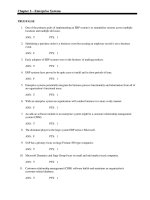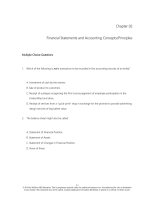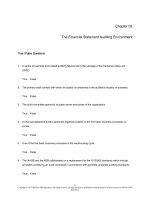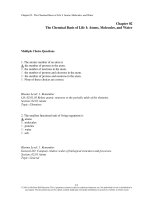Marine biology 10th edition castro test bank
Bạn đang xem bản rút gọn của tài liệu. Xem và tải ngay bản đầy đủ của tài liệu tại đây (21.97 KB, 8 trang )
Chapter 02 - The Sea Floor
Chapter 02
The Sea Floor
Multiple Choice Questions
1. How much of the Earth's surface is covered by the world ocean?
A. 53%
B. 65%
C. 71%
D. 78%
E. 80%
2. The largest percentage of the world ocean is found in the:
A. Northern hemisphere.
B. Southern hemisphere.
C. Eastern hemisphere.
D. Western hemisphere.
E. The ocean is evenly distributed.
3. One of the following is not one of the world's major ocean basins:
A. Atlantic Ocean.
B. Arctic Ocean.
C. Indian Ocean.
D. Antarctic Ocean.
E. Pacific Ocean.
4. The world's smallest and shallowest ocean is:
A. Atlantic Ocean.
B. Arctic Ocean.
C. Indian Ocean.
D. Antarctic Ocean.
E. Pacific Ocean.
2-1
Copyright © 2016 McGraw-Hill Education. All rights reserved. No reproduction or distribution without the prior written consent of
McGraw-Hill Education.
Chapter 02 - The Sea Floor
5. The world's largest and deepest ocean is:
A. Atlantic Ocean.
B. Arctic Ocean.
C. Indian Ocean.
D. Antarctic Ocean.
E. Pacific Ocean.
6. Oceanographers often use the name "Southern Ocean" to refer to the body of water:
A. Around Antarctica
B. In the South Pacific
C. South of the North Sea
D. South of Florida
E. Around the southern tip of India
7. The Big Bang was:
A. The origin of the Earth's magnetic field
B. The beginning of plate tectonics and continental drift
C. The origin of the oceans as water condensed on Earth
D. The giant cosmic explosion that occurred 13.7 billion years ago and created the Universe.
8. Density is:
A. The mass of a substance per unit volume
B. A measure of weight
C. The mass of a substance multiplied by its percentage volume of water
D. A measure of volume
E. The volume occupied by a particular substance in relation to that of water
9. There is evidence that the earth and the rest of the solar system formed about:
A. 5 million years ago
B. 1 billion years ago
C. 4.5 billion years ago
D. 10.5 billion years ago
E. 10 million years ago
2-2
Copyright © 2016 McGraw-Hill Education. All rights reserved. No reproduction or distribution without the prior written consent of
McGraw-Hill Education.
Chapter 02 - The Sea Floor
10. The semi-solid layer of the earth found below the crust and outside of the core is called
the:
A. Inner core
B. Mantle
C. Inner crust
D. Outer core
E. Oceanic crust
11. The earth's magnetic field is thought to be caused by movements of liquid metal in which
of the earth's layers?
A. Inner core.
B. Outer core.
C. Oceanic crust.
D. Mantle.
E. Continental crust.
12. The thinnest layer of the earth is the:
A. Inner core.
B. Outer core.
C. Crust.
D. Mantle.
13. Which of the following is not true of oceanic crust?
A. It is thinner than continental crust
B. It is denser than continental crust
C. It is geologically younger in most places than continental crust
D. It lies below sea level
E. It consists mostly of granite
2-3
Copyright © 2016 McGraw-Hill Education. All rights reserved. No reproduction or distribution without the prior written consent of
McGraw-Hill Education.
Chapter 02 - The Sea Floor
14. Which of the following is not true of mid-ocean ridges?
A. Earthquakes and volcanoes are associated with them
B. The sediment covering gets thinner as one moves away from them towards the continents
C. The rock on the sea floor is older as one moves away from them
D. Sea floor spreading is associated with them
E. All are interconnected
15. Which of the following is true about lithospheric plates?
A. Only contain continental crust
B. Only contain oceanic crust
C. Collide with one another at the mid-ocean ridge
D. Float on the upper mantle
E. Are directly connected with the inner core of the earth
16. Which of the following statements is NOT true?
A. Oceanic crust is made of a rock-type called basalt
B. Oceanic crust is denser than continental crust
C. Oceanic crust is thinner than continental crust
D. Oceanic crust is older than continental crust
E. There are significant chemical differences between oceanic and continental crust
17. Trenches are formed in areas where:
A. A plate is lifted by another
B. A plate moves along side another in a transform motion
C. A plate splits and opens up
D. Sea floor spreading takes place
E. A plate sinks beneath another
18. The process by which a lithospheric plate descends into the mantle is called:
A. Continental drift
B. Induction
C. Sea floor spreading
D. Subduction
E. Faulting
2-4
Copyright © 2016 McGraw-Hill Education. All rights reserved. No reproduction or distribution without the prior written consent of
McGraw-Hill Education.
Chapter 02 - The Sea Floor
19. The friction zone along the shear boundary such as the one in California between two
lithospheric plates is called a:
A. Fault
B. Rift
C. Trench
D. Mid-ocean ridge
E. Sea
20. WHich of these places is an example of an island arch along a trench:
A. Aleutian Islands
B. Hawaiian Islands
C. Australia
D. Galápagos Islands
E. Bermuda
21. Which in not a type of lithospheric plate boundary?
A. Shear boundary
B. Continental shelf
C. Trench
D. Mid-ocean ridge
22. The type of plate boundary where plates move past each other in a sort of lateral
motion is called:
A. Island arc
B. Subduction zone
C. Trench
D. Convection zone
E. Shear boundary
2-5
Copyright © 2016 McGraw-Hill Education. All rights reserved. No reproduction or distribution without the prior written consent of
McGraw-Hill Education.
Chapter 02 - The Sea Floor
23. Evidence of plate techtonics is provided by:
A. Magnetic anomalies/paleomagnetic evidence
B. Sea floor spreading
C. The existence of mid ocean ridges
D. All of the above
E. B and C only
24. (p. 31) The name of the vast single world ocean that was present about 200 million years
ago is:
A. Sinus Borealis
B. Pangaea
C. Tethys
D. Panthalassa
E. Gondwana
25. Lithogenous sediments are those that come from:
A. Plants
B. Living organisms in general
C. Deep-water volcanoes
D. Erosion of land
E. Corals
26. The outer edge of the continental margin is the:
A. Shelf break
B. Continental slope
C. Continental rise
D. Edge of the abyssal plain
E. Continental edge
2-6
Copyright © 2016 McGraw-Hill Education. All rights reserved. No reproduction or distribution without the prior written consent of
McGraw-Hill Education.
Chapter 02 - The Sea Floor
27. The steepest part of the continental margin where it descends down to the ocean floor is
known as the:
A. Shelf break
B. Continental slope
C. Continental rise
D. Edge of the abyssal plain
E. Continental edge
28. The shallow part of the continental margin that is closer to land and is a critical marine
habitat because light can reach all the way to the bottom in most of it is known as:
A. Shelf break
B. Continental slope
C. Continental rise
D. Edge of the abyssal plain
E. Continental shelf
29. The west coast of South America is an active continental margin. As such, it is
characterized by all of the following except:
A. Earthquakes
B. Volcanoes
C. Wide continental shelf
D. Steep and rocky shorelines
E. Steep continental slope
30. The east coast of the United States is a passive continental margin which is characterized
by:
A. Mountains along the coast
B. Steep and rocky shorelines
C. Narrow continental shelf
D. Offshore trench
E. Gentle continental slope
2-7
Copyright © 2016 McGraw-Hill Education. All rights reserved. No reproduction or distribution without the prior written consent of
McGraw-Hill Education.
Chapter 02 - The Sea Floor
31. Black smoker stacks or columns form as a result of the accumulation of:
A. Deep-water animals
B. Lava
C. Biogenous sediments
D. Metallic-sulfide minerals reacting with seawater
E. Material released from the formation of trenches
32. Sea levels have naturally fluctuated through the vast epochs of geologic time. What is
occurring now with regards to sea level?
A. Sea level is absolutely falling
B. Sea level is absolutely rising
C. Sea level always remains stable
D. Scientists are not sure
E. Sea level varies by location
33. The most biologically rich part of the ocean is the:
A. Shelf break
B. Continental shelf
C. Continental slope
D. Continental rise
E. Deep-sea floor
2-8
Copyright © 2016 McGraw-Hill Education. All rights reserved. No reproduction or distribution without the prior written consent of
McGraw-Hill Education.









